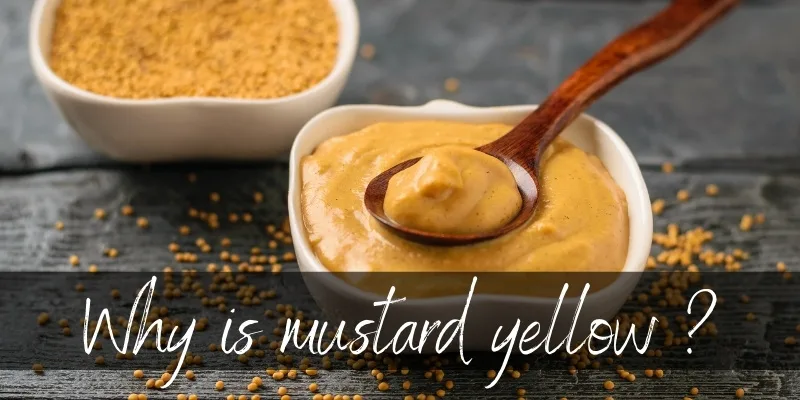Mustard is so often used in parks, at picnics, at a barbecue, on roadtrips, it’s in your burger and potato salad, it’s everywhere ! It add a nice pungent, sharp, sometimes hot flavor to whatever you’re eating. And in some cases it can be the saving grace of some meals.
Have you ever wondered why mustard is yellow ? Varying degrees of yellow, some murky, some nearly brown, some light yellow, and some are the brightest, almost neon yellow you’ve ever seen. But why ? It turns out there’s an interesting reason reason behind this.

Why is mustard yellow ?
Mustard is usually yellow because it is mixed with finely ground turmeric (curcuma). Turmeric is a bright, deep yellow with a very warm hue, and mustard seeds have a pale, grey-yellow color when ground and made into a paste.
The turmeric started out as a way to make mustard better looking. Now it’s the standard in the mustard making, and there are very few mustard companies that do not use turmeric.
Why mustard changed its color
The initial mustard – the one made by the Romans thousands of years ago – was a very bland-looking paste. It had ground mustard seeds, and unfermented grape juice (called must). This paste was vaguely yellow, with different flacks or brown or black. It was far from the yellow paste we know today.
For a very long time mustard was a sort of paste that was varying shades of murky grey-yellow-brown, depending on what kind of seeds were used. Somehow, over time, turmeric became more and more common in mustard.
English mustard is an old version of yellow mustard, and it had a bit of turmeric in it even back in 1814 (when Colman’s mustard started out). We can only assume that turmeric in mustard became a thing for aesthetics, and possibly for a bit of flavor too.
Read also: Kalamata VS Black Olives
As for why mustard is so reliably yellow, stories vary but here is the most common one. An enterprising American – the actual names used vary – had the idea to make a creamy mustard that was going to be a best seller on hotdogs. He decided to add some extra turmeric, to make it stand out form the rest, and it was a real hit.
American mustard then went on to be the brightest, most yellow mustard of them all. And as America has always had a good amount of international clout, other countries inspired themselves from this mustard type, if only in looks.
Common mustard types
All that being said, mustard does actually come in different colors and types. Really, all the mustard jars you can ever look at in a supermarket fall into one of these categories.
An important note: there are three mustard seed colors, and each has a slightly different flavor. There is yellow mustard, which is mild and not so pungent. There is brown mustard, which is strong, pungent, and hot. And there is black mustard, which is even stronger.
Yellow mustard seeds are the most commonly used ones, and why most mustards taste mostly the same. Other mustard types are actually stronger, more pungent, and it also has to do with when the seeds are mixed with.
The liquid can be hot or cold, basic or acidic. And acidic liquid – like vinegar – brings out a whole lot of heat and them stabilizes it, and is very reliable for storage. Basic liquid, like water, brings out the heat and pungency much slower.
English mustard
English mustard is made with yellow and a bit of brown mustard seeds, vinegar, and turmeric. It’s a pungent, mildly hot mustard that goes well on pretty much anything, be it hot or cold.
American yellow mustard
Yellow mustard is much more mellow than English mustard, and uses more turmeric. This makes it a great all-rounder, making it good for most meats and dishes. It’s come to be expected when serving hotdogs, burgers, and potato salad.
Dijon mustard
Dijon mustard is made a bit differently than other mustard types. It originally came from the town of Dijon, when a man decide to change the vinegar with verjuice (juice form green, unripe grapes). Nowadays Dijon mustard is made with white wine vinegar, and it’s not a protected name, meaning various producers can make it in any way they like, and still sell it as Dijon.

Coarse mustard
Corse mustard is simply made of mustard seeds that are not completely crushed and turned into a powder. This means some seeds are crushed, some are mostly intact, and some are already a paste. They have a lot of texture, and they almost always use all three types of mustard seeds, leading to a very hot mustard.
Sweet mustard
Sweet mustard has different food items as sweeteners, like honey, maple syrup, plain sugar, or even different fruit. It’s not exceedingly sweet, but it can definitely bring a sweet note to any meal.
Hot mustard
Hot mustard is usually made with brown and black mustard seeds, and once it’s mixed with turmeric it ends up as a dark yellow, nearly brown color. The brown and black seeds are hot, very hot and pungent.
Sometimes though you can find hot mustard made with yellow seeds and horseradish, to simulate that sinus-clearing pungency their darker seeds have.
And sometimes, you can find mustard types that are a blend of several types. We’ve seen Dijon with quite a few coarse seeds, we’ve seen hot and sweet mustard, and we’ve seen coarse and sweet. Really, you can find all kinds of mustard in all kinds of combinations.

